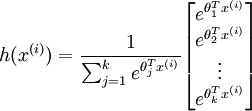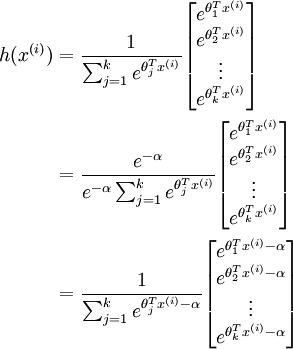Exercise : Softmax Regression
Step 0: Initialize constants and parameters
Step 1: Load data
Step 2: Implement softmaxCost
Implementation Tip: Preventing overflows - in softmax regression, you will have to compute the hypothesis
When the products
are large, the exponential function
will become very large and possibly overflow. When this happens, you will not be able to compute your hypothesis. However, there is an easy solution - observe that we can multiply the top and bottom of the hypothesis by some constant without changing the output:
Hence, to prevent overflow, simply subtract some large constant value from each of the
terms before computing the exponential. In practice, for each example, you can use the maximum of the
terms as the constant. Assuming you have a matrix M containing these terms such that M(r, c) is
, then you can use the following code to accomplish this:
% M is the matrix as described in the text
M = bsxfun(@minus, M, max(M, [], 1));Implementation Tip: Computing the predictions - you may also find bsxfun useful in computing your predictions - if you have a matrix M containing the
terms, such that M(r, c) contains the
term, you can use the following code to compute the hypothesis (by dividing all elements in each column by their column sum):
% M is the matrix as described in the text
M = bsxfun(@rdivide, M, sum(M))
Step 3: Gradient checking
Implementation Tip: Faster gradient checking - when debugging, you can speed up gradient checking by reducing the number of parameters your model uses. In this case, we have included code for reducing the size of the input data, using the first 8 pixels of the images instead of the full 28x28 images. This code can be used by setting the variable DEBUG to true, as described in step 1 of the code.
Step 4: Learning parameters
Step 5: Testing
Our implementation achieved an accuracy of 92.6%. If your model's accuracy is significantly less (less than 91%), check your code, ensure that you are using the trained weights, and that you are training your model on the full 60000 training images. Conversely, if your accuracy is too high (99-100%), ensure that you have not accidentally trained your model on the test set as well.
matlab : row 行(横) column 列(纵)
%% CS294A/CS294W Softmax Exercise % Instructions
% ------------
%
% This file contains code that helps you get started on the
% softmax exercise. You will need to write the softmax cost function
% in softmaxCost.m and the softmax prediction function in softmaxPred.m.
% For this exercise, you will not need to change any code in this file,
% or any other files other than those mentioned above.
% (However, you may be required to do so in later exercises) %%======================================================================
%% STEP : Initialise constants and parameters
%
% Here we define and initialise some constants which allow your code
% to be used more generally on any arbitrary input.
% We also initialise some parameters used for tuning the model. inputSize = * ; % Size of input vector (MNIST images are 28x28)
numClasses = ; % Number of classes (MNIST images fall into classes) lambda = 1e-; % Weight decay parameter %%======================================================================
%% STEP : Load data
%
% In this section, we load the input and output data.
% For softmax regression on MNIST pixels,
% the input data is the images, and
% the output data is the labels.
% % Change the filenames if you've saved the files under different names
% On some platforms, the files might be saved as
% train-images.idx3-ubyte / train-labels.idx1-ubyte images = loadMNISTImages('train-images.idx3-ubyte');
labels = loadMNISTLabels('train-labels.idx1-ubyte');
labels(labels==) = ; % Remap to inputData = images; % For debugging purposes, you may wish to reduce the size of the input data
% in order to speed up gradient checking.
% Here, we create synthetic dataset using random data for testing % DEBUG = true; % Set DEBUG to true when debugging.
DEBUG = false;
if DEBUG
inputSize = ;
inputData = randn(, );
labels = randi(, , );
end % Randomly initialise theta
theta = 0.005 * randn(numClasses * inputSize, );%输入的是一个列向量 %%======================================================================
%% STEP : Implement softmaxCost
%
% Implement softmaxCost in softmaxCost.m. [cost, grad] = softmaxCost(theta, numClasses, inputSize, lambda, inputData, labels); %%======================================================================
%% STEP : Gradient checking
%
% As with any learning algorithm, you should always check that your
% gradients are correct before learning the parameters.
% if DEBUG
numGrad = computeNumericalGradient( @(x) softmaxCost(x, numClasses, ...
inputSize, lambda, inputData, labels), theta); % Use this to visually compare the gradients side by side
disp([numGrad grad]); % Compare numerically computed gradients with those computed analytically
diff = norm(numGrad-grad)/norm(numGrad+grad);
disp(diff);
% The difference should be small.
% In our implementation, these values are usually less than 1e-. % When your gradients are correct, congratulations!
end %%======================================================================
%% STEP : Learning parameters
%
% Once you have verified that your gradients are correct,
% you can start training your softmax regression code using softmaxTrain
% (which uses minFunc). options.maxIter = ;
%softmaxModel其实只是一个结构体,里面包含了学习到的最优参数以及输入尺寸大小和类别个数信息
softmaxModel = softmaxTrain(inputSize, numClasses, lambda, ...
inputData, labels, options); % Although we only use iterations here to train a classifier for the
% MNIST data set, in practice, training for more iterations is usually
% beneficial. %%======================================================================
%% STEP : Testing
%
% You should now test your model against the test images.
% To do this, you will first need to write softmaxPredict
% (in softmaxPredict.m), which should return predictions
% given a softmax model and the input data. images = loadMNISTImages('t10k-images.idx3-ubyte');
labels = loadMNISTLabels('t10k-labels.idx1-ubyte');
labels(labels==) = ; % Remap to inputData = images;
size(softmaxModel.optTheta)
size(inputData) % You will have to implement softmaxPredict in softmaxPredict.m
[pred] = softmaxPredict(softmaxModel, inputData); acc = mean(labels(:) == pred(:));
fprintf('Accuracy: %0.3f%%\n', acc * ); % Accuracy is the proportion of correctly classified images
% After iterations, the results for our implementation were:
%
% Accuracy: 92.200%
%
% If your values are too low (accuracy less than 0.91), you should check
% your code for errors, and make sure you are training on the
% entire data set of 28x28 training images
% (unless you modified the loading code, this should be the case)function [cost, grad] = softmaxCost(theta, numClasses, inputSize, lambda, data, labels) % numClasses - the number of classes
% inputSize - the size N of the input vector
% lambda - weight decay parameter
% data - the N x M input matrix, where each column data(:, i) corresponds to
% a single test set
% labels - an M x matrix containing the labels corresponding for the input data
% % Unroll the parameters from theta
theta = reshape(theta, numClasses, inputSize);%将输入的参数列向量变成一个矩阵 numCases = size(data, );%输入样本的个数
groundTruth = full(sparse(labels, :numCases, ));%这里sparse是生成一个稀疏矩阵,该矩阵中的值都是第三个值1
%稀疏矩阵的小标由labels和1:numCases对应值构成
cost = ; thetagrad = zeros(numClasses, inputSize); %% ---------- YOUR CODE HERE --------------------------------------
% Instructions: Compute the cost and gradient for softmax regression.
% You need to compute thetagrad and cost.
% The groundTruth matrix might come in handy. M = bsxfun(@minus,theta*data,max(theta*data, [], ));
M = exp(M);
p = bsxfun(@rdivide, M, sum(M));
cost = -/numCases * groundTruth(:)' * log(p(:)) + lambda/2 * sum(theta(:) .^ 2);
thetagrad = -/numCases * (groundTruth - p) * data' + lambda * theta; % ------------------------------------------------------------------
% Unroll the gradient matrices into a vector for minFunc
grad = [thetagrad(:)];
endfunction [softmaxModel] = softmaxTrain(inputSize, numClasses, lambda, inputData, labels, options)
%softmaxTrain Train a softmax model with the given parameters on the given
% data. Returns softmaxOptTheta, a vector containing the trained parameters
% for the model.
%
% inputSize: the size of an input vector x^(i)
% numClasses: the number of classes
% lambda: weight decay parameter
% inputData: an N by M matrix containing the input data, such that
% inputData(:, c) is the cth input
% labels: M by matrix containing the class labels for the
% corresponding inputs. labels(c) is the class label for
% the cth input
% options (optional): options
% options.maxIter: number of iterations to train for if ~exist('options', 'var')
options = struct;
end if ~isfield(options, 'maxIter')
options.maxIter = ;
end % initialize parameters
theta = 0.005 * randn(numClasses * inputSize, ); % Use minFunc to minimize the function
addpath minFunc/
options.Method = 'lbfgs'; % Here, we use L-BFGS to optimize our cost
% function. Generally, for minFunc to work, you
% need a function pointer with two outputs: the
% function value and the gradient. In our problem,
% softmaxCost.m satisfies this.
minFuncOptions.display = 'on'; [softmaxOptTheta, cost] = minFunc( @(p) softmaxCost(p, ...
numClasses, inputSize, lambda, ...
inputData, labels), ...
theta, options); % Fold softmaxOptTheta into a nicer format
softmaxModel.optTheta = reshape(softmaxOptTheta, numClasses, inputSize);
softmaxModel.inputSize = inputSize;
softmaxModel.numClasses = numClasses; endfunction [pred] = softmaxPredict(softmaxModel, data) % softmaxModel - model trained using softmaxTrain
% data - the N x M input matrix, where each column data(:, i) corresponds to
% a single test set
%
% Your code should produce the prediction matrix
% pred, where pred(i) is argmax_c P(y(c) | x(i)). % Unroll the parameters from theta
theta = softmaxModel.optTheta; % this provides a numClasses x inputSize matrix
pred = zeros(, size(data, )); %% ---------- YOUR CODE HERE --------------------------------------
% Instructions: Compute pred using theta assuming that the labels start
% from . [nop, pred] = max(theta * data);
% pred= max(peed_temp); % --------------------------------------------------------------------- end
Exercise : Softmax Regression的更多相关文章
- 【DeepLearning】Exercise:Softmax Regression
Exercise:Softmax Regression 习题的链接:Exercise:Softmax Regression softmaxCost.m function [cost, grad] = ...
- Deep Learning 学习随记(三)续 Softmax regression练习
上一篇讲的Softmax regression,当时时间不够,没把练习做完.这几天学车有点累,又特别想动动手自己写写matlab代码 所以等到了现在,这篇文章就当做上一篇的续吧. 回顾: 上一篇最后给 ...
- ufldl学习笔记和编程作业:Softmax Regression(softmax回报)
ufldl学习笔记与编程作业:Softmax Regression(softmax回归) ufldl出了新教程.感觉比之前的好,从基础讲起.系统清晰,又有编程实践. 在deep learning高质量 ...
- 深度学习 Deep Learning UFLDL 最新Tutorial 学习笔记 5:Softmax Regression
Softmax Regression Tutorial地址:http://ufldl.stanford.edu/tutorial/supervised/SoftmaxRegression/ 从本节開始 ...
- ufldl学习笔记与编程作业:Softmax Regression(vectorization加速)
ufldl学习笔记与编程作业:Softmax Regression(vectorization加速) ufldl出了新教程,感觉比之前的好.从基础讲起.系统清晰,又有编程实践. 在deep learn ...
- Softmax回归(Softmax Regression)
转载请注明出处:http://www.cnblogs.com/BYRans/ 多分类问题 在一个多分类问题中,因变量y有k个取值,即.例如在邮件分类问题中,我们要把邮件分为垃圾邮件.个人邮件.工作邮件 ...
- (六)6.10 Neurons Networks implements of softmax regression
softmax可以看做只有输入和输出的Neurons Networks,如下图: 其参数数量为k*(n+1) ,但在本实现中没有加入截距项,所以参数为k*n的矩阵. 对损失函数J(θ)的形式有: 算法 ...
- UFLDL实验报告1: Softmax Regression
PS:这些是今年4月份,跟斯坦福UFLDL教程时的实验报告,当时就应该好好整理的…留到现在好凌乱了 Softmax Regression实验报告 1.Softmax Regression实验描述 So ...
- 学习笔记TF024:TensorFlow实现Softmax Regression(回归)识别手写数字
TensorFlow实现Softmax Regression(回归)识别手写数字.MNIST(Mixed National Institute of Standards and Technology ...
随机推荐
- 大数问题(相加) A + B
I have a very simple problem for you. Given two integers A and B, your job is to calculate the Sum o ...
- Object-C,遍历目录
最近武汉连续下雨很多天,降温了2次,温度一下子由28度到14度,再到8度,手太冷了. 加上最近发生了一些比较棘手的家庭琐事,最近没心情继续学习Object-C. 后来,我想明白了,心情不好的时候,还是 ...
- Git学习总结(6)——作为一名程序员这些代码托管工具你都知道吗?
作为一名程序员这些代码托管工具你都知道吗? 作为一名优秀的开发者,大家都会用到代码托管,我本人用的是github,确实github里面有很多很多开源的项目,所以我们目前的创业项目程序员客栈www.pr ...
- UVA10269 Adventure of Super Mario(Floyd+DP)
UVA10269 Adventure of Super Mario(Floyd+DP) After rescuing the beautiful princess, Super Mario needs ...
- 洛谷 P3068 [USACO13JAN]派对邀请函Party Invitations
P3068 [USACO13JAN]派对邀请函Party Invitations 题目描述 Farmer John is throwing a party and wants to invite so ...
- struts2文件过滤拦截器fileUpload以及各种文件类型
本文某些内容复制自:http://zhidao.baidu.com/link?url=F0Z-FqbZ83BOj_xXp_B8rgJDzUoeVSWGgXwPNP5fEdLU1nvBK7yO4vnX_ ...
- django-xadmin使用之更改菜单url
环境:xadmin-for-python3 python3.5.2 django1.9.12 1. 在模块的adminx.py文件中增加以下代码: class AdminSettings(object ...
- JAVA并发-内置锁和ThreadLocal
上一篇博客讲过,当多个线程访问共享的可变变量的时候,可以使用锁来进行线程同步.那么如果线程安全性存在的3个前提条件不同时存在的话,自然就不需要考虑线程安全性了.或者说如果我们能够将某个共享变量变为局部 ...
- OSSIM(开源安全信息管理系统)在企业网络管理中的应用
国内首个Ossim技术交流群(179084574),欢迎加入我们 参与51CTO[第242期]OSSIM,企业信息安全管理利器热门技术讨论 650) this.width=650;" bor ...
- IIS 优化
http://www.cnblogs.com/wangjingblogs/archive/2013/02/27/2934706.html 通过对IIS7的配置进行优化,调整IIS7应用池的队列长度,请 ...


